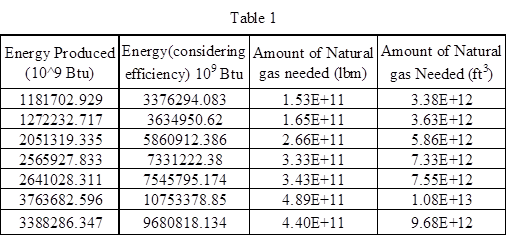Given data:
Refer to problem 13-19 accompanying table in the textbook.
The average efficiency of the power plant is 35%.
The heating value of the natural gas is 1000 Btuft3 (22000 Btulbm).
Formula used:
Formula to calculate the power plant efficiency is,
Power plant effeicency=Energy generatedEnergy input from fuel
Rearrange the equation,
Energy input from fuel=Energy generatedpower plant effeicency (1)
Convert Btu to lbm,
1 Btu=122000 lbm [∴ 22000 Btulbm=1]=4.5454×10−5 lbm (2)
Convert lbm to ft3,
1000 Btuft3=22000 Btulbm1000 1ft3=22000 1lbm1ft3=22 1lbm1 lbm=22 ft3 (3)
The value of the 1 Btus is,
1 Btus=1.055 kW (4)
Convert 1 hr into seconds,
1 hr=3600 s
Rearrange the equation,
1 s=13600 hr (5)
Substitute equation (5) in equation (4),
1 Btu13600 hr=1.055 kW1 Btu=1.0553600 kWhr1 Btu=2.93×10−4 kWhr
Rearrange the equation,
1 kWhr=12.93×10−4 Btu=3412.96 Btu
Calculation:
Converting the given data from kWh to Btu:
Substitute 3412.96 Btu for 1 kWhr in 346.2399×109 kWhr for the year 1980,
346.2399×109 kWhr=(346.2399×109)(3412.96 Btu)=1.181702929×1015 Btu=1181702.929×109 Btu
Substitute 3412.96 Btu for 1 kWhr in 372.7652×109 kWhr for the year 1990,
372.7652×109 kWhr=(372.7652×109)(3412.96 Btu)=1.272232717×1015 Btu=1272232.717×109 Btu
Substitute 3412.96 Btu for 1 kWhr in 601.0382×109 kWhr for the year 2000,
601.0382×109 kWhr=(601.0382×109)(3412.96 Btu)=2.051319335×1015 Btu=2051319.335×109 Btu
Substitute 3412.96 Btu for 1 kWhr in 751.8189×109 kWhr for the year 2005,
751.8189×109 kWhr=(751.8189×109 kWhr)(3412.96 Btu)=2.565927833×1015 Btu=2565927.833×109 Btu
Substitute 3412.96 Btu for 1 kWhr in 773.8234×109 kWhr for the year 2010,
773.8234×109 kWhr=(773.8234×109)(3412.96 Btu)=2.641028311×1015 Btu=2641028.311×109 Btu
Substitute 3412.96 Btu for 1 kWhr in 1102.762×109 kWhr for the year 2020,
1102.762×109 kWhr=(1102.762×109)(3412.96 Btu)=3.763682596×1015 Btu=3763682.596×109 Btu
Substitute 3412.96 Btu for 1 kWhr in 992.7706×109 kWhr for the year 2030,
992.7706×109 kWhr=(992.7706×109)(3412.96 Btu)=3.388286347×1015 Btu=3388286.347×109 Btu
Now find the energy input fuel for each year in Btu for natural gas:
Substitute 1181702.929×109 Btu for energy generated and 0.35 for power plant efficiency in equation (1) to find energy input from fuel in 1980,
Energy input from fuel=1181702.929×109 Btu0.35=3.376294083×1015 BtuEnergy input from fuel=3376294.083×109 Btu
Substitute 1272232.717×109 Btu for energy generated and 0.35 for power plant efficiency in equation (1) to find energy input from fuel 1990,
Energy input from fuel=1272232.717×109 Btu0.35=3.63495062×1015 BtuEnergy input from fuel=3634950.62×109 Btu
Substitute 2051319.335×109 Btu for energy generated and 0.35 for power plant efficiency in equation (1) to find energy input from fuel 2000,
Energy input from fuel=2051319.335×109 Btu0.35=5.860912386×1015 BtuEnergy input from fuel=5860912.386×109 Btu
Substitute 2565927.833×109 Btu for energy generated and 0.35 for power plant efficiency in equation (1) to find energy input from fuel 2005,
Energy input from fuel=2565927.833×109 Btu0.35=7.33122238×1015 BtuEnergy input from fuel=7331222.38×109 Btu
Substitute 2641028.311×109 Btu for energy generated and 0.35 for power plant efficiency in equation (1) to find energy input from fuel 2010,
Energy input from fuel=2641028.311×109 Btu0.35=7.545795174×1015 BtuEnergy input from fuel=7545795.174×109 Btu
Substitute 3763682.596×109 Btu for energy generated and 0.35 for power plant efficiency in equation (1) to find energy input from fuel 2020,
Energy input from fuel=3763682.596×109 Btu0.35=1.075337885×1016 BtuEnergy input from fuel=10753378.85×109 Btu
Substitute 3388326.347×109 Btu for energy generated and 0.35 for power plant efficiency in equation (1) to find energy input from fuel 2030,
Energy input from fuel=3388286.347×109 Btu0.35=9680818.134×109 Btu
Now convert Btu to lbm as follows by using the relation 1 Btu=4.5454×10−5 lbm,
Substitute 4.5454×10−5 lbm for 1 Btu in 3376294.083×109 Btu for the year 1980,
3376294.083×109 Btu=(3376294.083×109)(4.5454×10−5 lbm)=1.5346607×1011 lbm≅1.53×1011 lbm
Substitute 4.5454×10−5 lbm for 1 Btu in 3634950.62×109 Btu for the year 1990,
3634950.62×109 Btu=(3634950.62×109)(4.5454×10−5 lbm)=1.652230×1011 lbm≅1.65×1011 lbm
Substitute 4.5454×10−5 lbm for 1 Btu in 5860912.386×109 Btu for the year 2000,
5860912.386×109 Btu=(5860912.386×109)(4.5454×10−5 lbm)=2.664019×1011 lbm≅2.66×1011 lbm
Substitute 4.5454×10−5 lbm for 1 Btu in 7331222.38×109 Btu for the year 2005,
7331222.38×109 Btu=(7331222.38×109)(4.5454×10−5 lbm)=3.3323×1011 lbm≅3.33×1011 lbm
Substitute 4.5454×10−5 lbm for 1 Btu in 7545795.174×109 Btu for the year 2010,
7545795.174×109 Btu=(7545795.174×109)(4.5454×10−5 lbm)=3.429865×1011 lbm≅3.43×1011 lbm
Substitute 4.5454×10−5 lbm for 1 Btu in 10753378.85×109 Btu for the year 2020,
10753378.85×109 Btu=(10753378.85×109)(4.5454×10−5 lbm)=4.88784×1011 lbm≅4.89×1011 lbm
Substitute 4.5454×10−5 lbm for 1 Btu in 9680818.134×109 Btu for the year 2030,
9680818.134×109 Btu=(9680818.134×109) (4.5454×10−5 lbm)=4.4003190×1011 lbm≅4.40×1011 lbm
Now convert Form lbm to ft3 by using the relation 1lbm=22 ft3 as follows,
Substitute 22 ft3 for 1 lbm in 1.5346607×1011 lbm for the year 1980,
1.5346607×1011 lbm=(1.5346607×1011)(22 ft3)=3.37625×1012 ft3≅3.38×1012 ft3
Substitute 22 ft3 for 1 lbm in 1.652230×1012 lbm for the year 1990,
1.652230×1011 lbm=(1.652230×1011)(22 ft3)=3.6354906 ×1012 ft3≅3.63 ×1012 ft3
Substitute 22 ft3 for 1 lbm in 2.664019×1012 lbm for the year 2000,
2.664019×1011 lbm=(2.664019×1011)(22 ft3)=5.8608418×1012 ft3≅5.86×1012 ft3
Substitute 22 ft3 for 1 lbm in 3.33233×1010 lbm for the year 2005,
3.33233×1011 lbm=(3.33233×1011)(22 ft3)=7.331126×1012 ft3≅7.33×1012 ft3
Substitute 22 ft3 for 1 lbm in 3.429865×1011 lbm for the year 2010,
3.429865×1011 lbm=(3.429865×1011)(22 ft3)=7.545703×1012 ft3≅7.55×1012 ft3
Substitute 22 ft3 for 1 lbm in 4.88784×1011 lbm for the year 2020,
4.88784×1011 lbm=(4.88784×1011)(22 ft3)=1.0753358×1013 ft3≅1.08×1013 ft3
Substitute 22 ft3 for 1 lbm in 4.400319×1011 lbm for the year 2030,
4.400319×1011 lbm=(4.400319×1011)(22 ft3)=9.6807018×1012 ft3≅9.68×1012 ft3
Therefore, the amount of natural gas in ft3 and lbm for generating electricity for each year required is tabulated as in Table 1 with approximately rounded values for amount of natural gas needed in lbm and amount of natural gas needed in ft3.

Conclusion:
Hence, the amount of natural gas in ft3 and lbm for generating electricity for each year has been calculated.


 Engineering Fundamentals: An Introduction to Engi...Civil EngineeringISBN:9781305084766Author:Saeed MoaveniPublisher:Cengage Learning
Engineering Fundamentals: An Introduction to Engi...Civil EngineeringISBN:9781305084766Author:Saeed MoaveniPublisher:Cengage Learning

